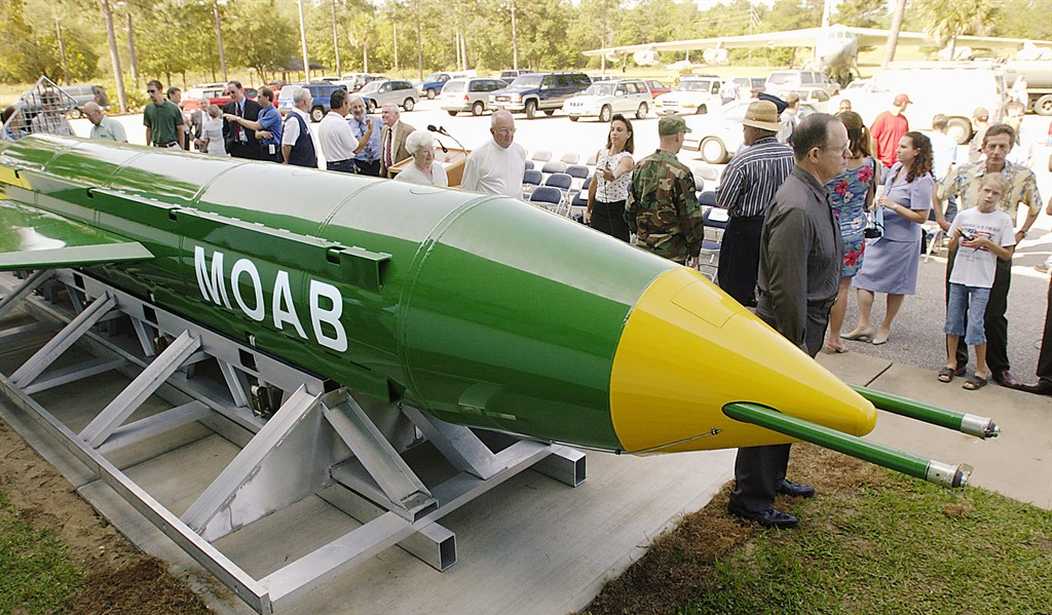The estimate yesterday was 36 killed. Today it’s nearly tripled. Why? Probably because Afghan authorities not only have a much larger blast radius than usual to comb for bodies, but because the target was an ISIS tunnel complex. Who knows how many dead jihadis they’re still discovering underground.
“Our team is in the area and they are doing clearance, so the figure might change as they find more bodies,” said Dawlat Waziri, a spokesman for the Afghan Ministry of Defense…
Hamdullah Mohib, Afghanistan’s ambassador to the United States, said the colossal MOAB was dropped after fighting had intensified over the last week. US and Afghan forces had been unable to advance because ISIS — which has expanded into Afghanistan in recent years — had mined the area with explosives.
As was widely reported Thursday, the MOAB dates to the beginning of the Iraq war but was never used in combat until this week. You can understand why. The bigger the boom, the greater the chance of civilian deaths as collateral damage. Ideally you’d want to use it against a sizable concentration of enemy fighters located far away from population centers, a rare scenario during the war on terror given jihadi guerrilla tactics. But that’s the opportunity that presented itself this week; per CNN, 3,000 Afghan families had fled the area over the past year, leaving ISIS all alone. The fact that tunnels were being targeted made the opportunity more attractive still. The pressure wave created by the MOAB is enormous, capable of penetrating the tunnels and creating cave-ins, and the giant fireball it creates burns up the oxygen, suffocating enemies inside. “It’s a way to get into areas where conventional bombs can’t reach,” said one expert. (For more strongly fortified underground facilities, the U.S. has the MOP.) If not for the MOAB, infantry would have had to fight their way past those tunnels.
And of course, as the Air Force acknowledges, the sheer magnitude of the explosion has “psychological effects.” The commander who ordered it had that in mind, according to a source who spoke to NBC: “[Gen.] Nicholson wanted to demonstrate to leaders of the ISIS affiliate in Afghanistan the seriousness of his determination to eliminate the group as a military threat.” It may end up having “psychological effects” in Syria and North Korea too, although since it wasn’t Trump who ordered the bomb’s use, any deterrent effect on other American enemies in the White House’s crosshairs right now is a happy coincidence. Unfortunately, with a blast this size, there are also “psychological effects” on local Afghans. There were no civilians close enough to be injured by the explosion, but they were plenty close enough to have heard — and felt — it:
After his evening prayers, Mohammad Shahzadah closed the house gates and sat down for dinner. Then the blast came, engulfing the sky in flames and sending tremors through the ground.
“The earth felt like a boat in a storm,” Shahzadah said. “I thought my house was being bombed. Last year a drone strike targeted a house next to mine, but this time it felt like the heavens were falling. The children and women were very scared.”…
“My ears were deaf for a while. My windows and doors are broken. There are cracks in the walls,” he said.
His home is a mile and a half away from where the bomb detonated.
Naturally, with the U.S. showing off the size of its arsenal this week, Russia and its apologists are reminding the world via social media that they have a conventional bomb much bigger than even the MOAB. Meet … the Father of All Bombs. Don’t be surprised if we get to see that in Syria or Ukraine soon.








Join the conversation as a VIP Member